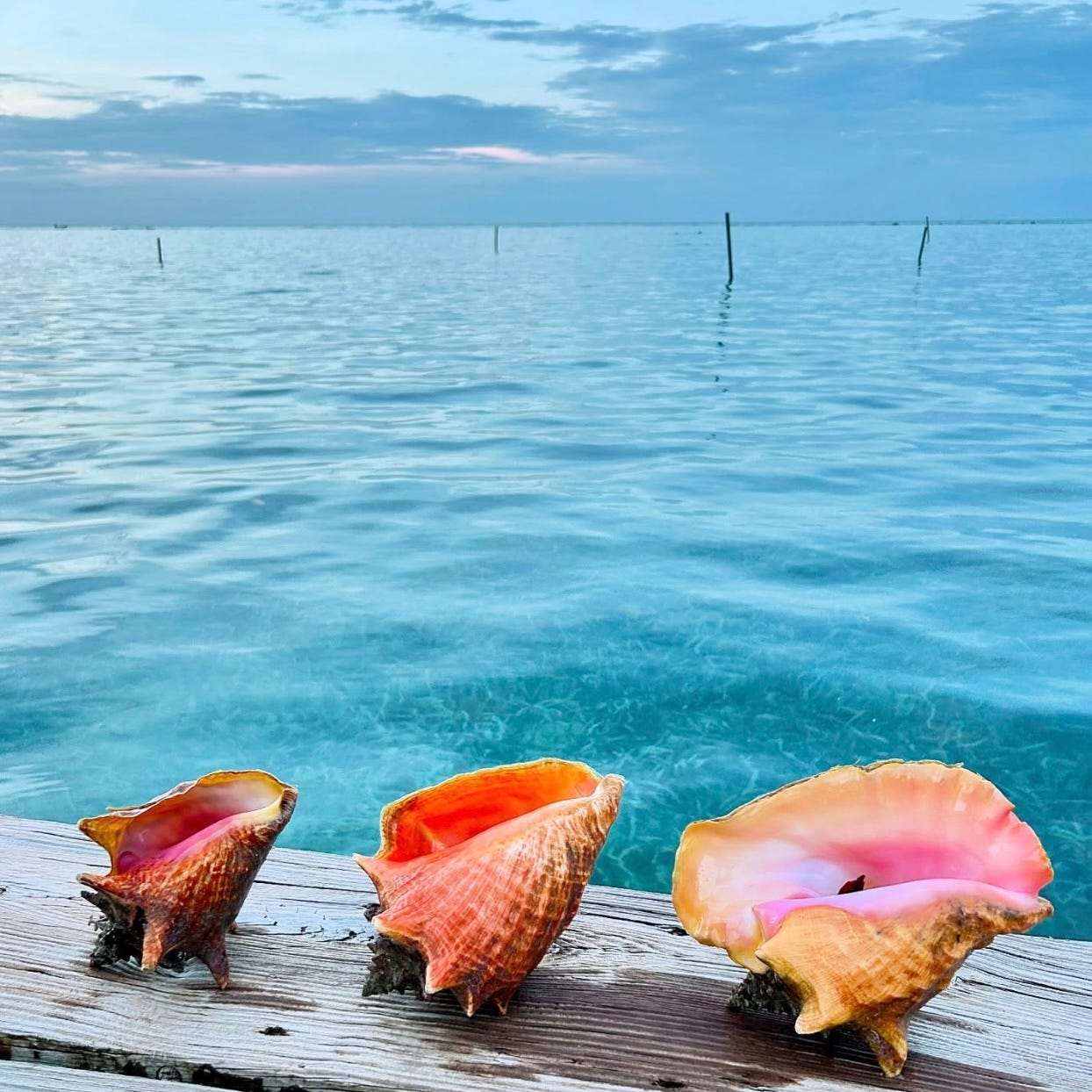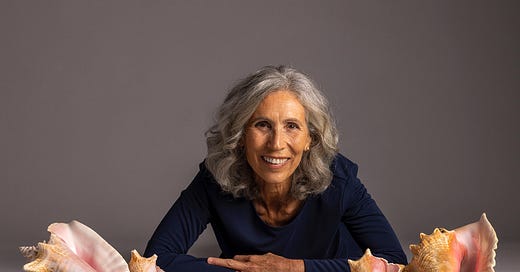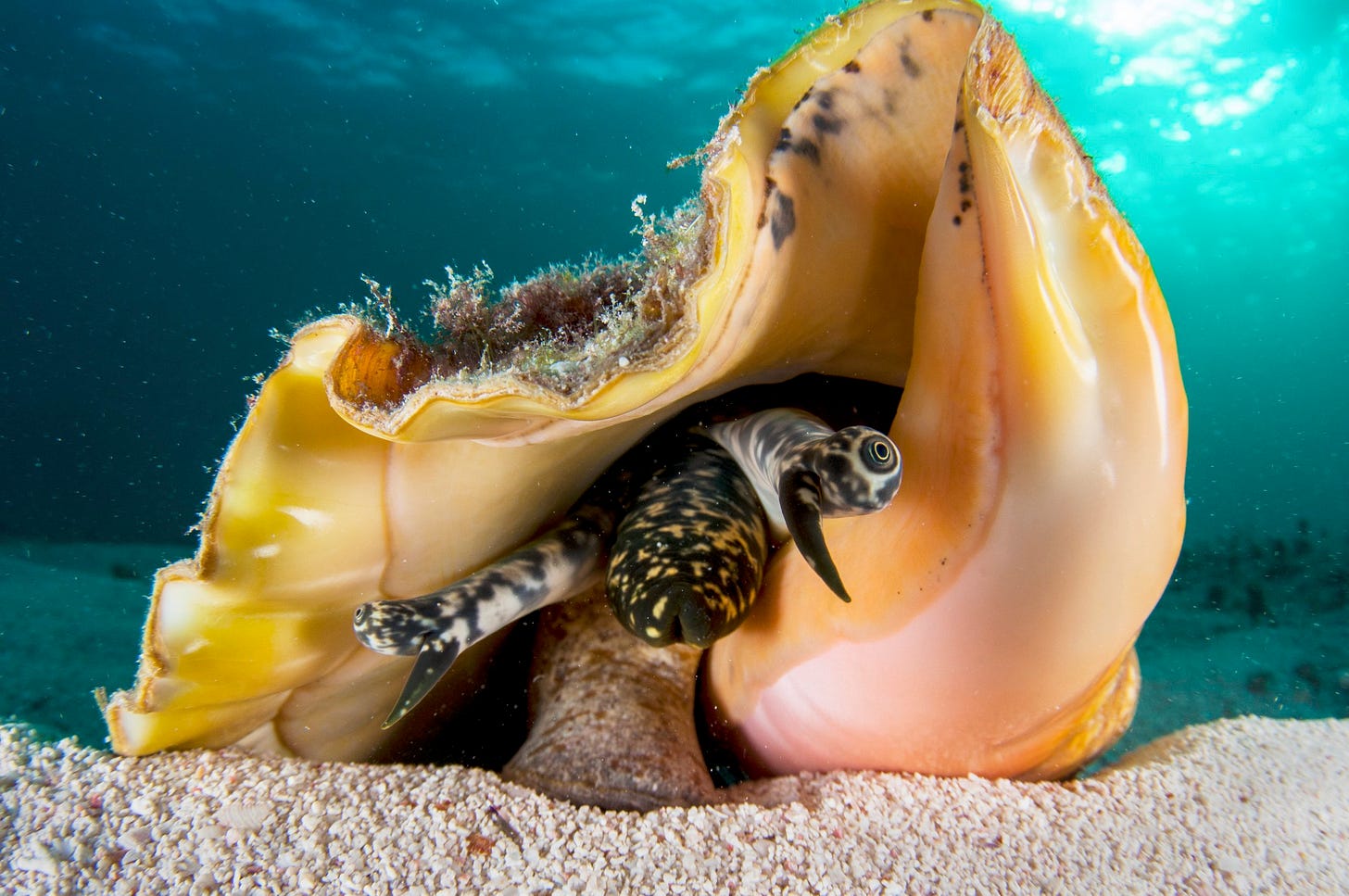The Queen Conch needs us...and I’m all in
Learning about the beautiful Queen Conch from the amazing Dr. Megan Davis
You don’t usually hear from me on Thursdays, I know—but I didn’t want to wait until Monday to tell you guys about this. I am really excited to announce that, through my Longer Tables Fund, we have started supporting an amazing project in the Caribbean supporting community-based aquaculture, specifically working with the amazing and beautiful (and delicious!) queen conch.
If you know me, you know I love the ocean. I love everything about it—exploring, snorkeling, scuba diving, spearfishing…and of course eating anything that I can find from the sea! I have traveled all around the world to scuba dive, and am always returning to a few locations in the Caribbean, like Grand Cayman and The Bahamas to dive under the stunning blue water, looking at the coral, the fishes, the forests of sea life that we usually forget about when we live our lives on land. I’ve spent a lot of time in The Bahamas, both visiting my restaurant Fish and after Hurricane Dorian in 2019, when World Central Kitchen was active on islands across the country. And of course I love eating conch, especially the conch salad at McKenzie’s Fresh Fish and Conch…if you ever go to Nassau, give them a visit.
So when I heard about the Queen Conch Lab project of Florida Atlantic University, and the amazing Dr. Megan Davis, I was excited to support them.
Megan is one of the most knowledgeable people in the world about queen conch aquaculture, and she’s spent 50 years studying conchs and developing community-based hatcheries across the Caribbean to support conservation and local economies. Her work not only empowers fisherwomen and fishermen through sustainable livelihoods, but it also contributes to climate change mitigation, specifically by restoring conch to seagrass habitats for carbon sequestration.
With support from my Longer Tables Fund, Megan, assistant director Becky Holt, and their team are able to build the ninth mobile queen conch hatchery across the Caribbean on the island of Eleuthera in The Bahamas, in partnership with The Island School’s Cape Eleuthera Institute. This project supports their mission to advance aquaculture conservation, restoration, and education, which benefits the species, the ecosystem, and the local communities that rely on queen conch for their livelihoods and as a vital source of nutrition. Their long-term vision is to have a community-based queen conch farm in every Caribbean country by 2030! I can get behind that!
So today I wanted to share with you an interview with Megan herself, who is so thoughtful about the sea, about the conchs, and about life itself. My team from Longer Tables Fund spoke with her…here you go with the conversation.

Let’s start with a basic question: What is a conch?
Megan: So conch is a mollusk or a shellfish or a marine snail, which might be the best description, like the land snails we’re all familiar with. Conch is a snail that lives in the ocean, and because it's a mollusk, it has no backbone, so it's an invertebrate. There's even a song written in the islands called The Conch Ain’t Got No Bone. So conchs need a shell…it's so interesting because humans have a skeleton on the inside and our flesh on the outside, whereas the conch needs the shell which is on the outside and its soft body parts are protected inside.
What value does a conch have to its ecosystem in The Bahamas?
I think a good analogy would be the rainforest—the seagrass is the rainforest, so it needs to be well-maintained in order to be productive. And the rainforest sequesters carbon in a terrestrial setting, while the seagrass does it underwater. So well-maintained seagrass helps to neutralize the excess carbon that happens in our world today with the climate changing and also of the water changing. When I first started my work in the ocean, the pH used to be 8.2—slightly on the alkaline side. And now it's 8.1. That might not sound like a lot, but for an animal like a conch that has a calcium carbonate shell, if the acidity of the water goes too low, it'll actually start to degrade the shell or it might not be able to produce the shell at all. So if we have healthy seagrasses, we can trap some of that excess carbon into the water system to help prevent that ocean acidification.
What does conch mean to the communities of the Bahamas and around the Caribbean?
When you think of conch, you do think of the Caribbean because it's such an iconic species throughout the region, from Florida all the way to Bermuda and down to Central America. Conch really began as a subsistence food source for people everywhere in the area…it goes way back in history, not only as a food source, and over the past decades as an important livelihood, whether as an artisanal conch fishing project or one that’s more commercial. People also use the shell as a tool, as has happened throughout human civilization.
What's the value in conch farming, the kind of work that you've been doing for so many years?
The importance of conch farming is one of many solutions to supply and demand. Obviously there needs to be regulations on the amount of conch that can be fished. There's the convention on international trade in endangered species in 1992, which put conch on the list to make sure that each country exporting conch and fishing conch fell within sustainable fishing management and these regulations. But within those regulations, it’s difficult for fishers to catch enough conch to meet demand, which is why aquaculture is one of the pieces of the puzzle—farmed conch can supplement the conch that are fished.
So, what we do is build community-based, small conch farms—2,000 to 10,000 conch a year. And the idea is that it's a restoration project to help rebuild populations and areas that need to be rebuilt. And then as you're rebuilding those populations, it puts more conch back out in the ocean so that the fishermen can fish them for food. But also importantly we’re creating more breeding areas because we need the breeding moms and dads so that we can have more eggs that are laid.
Every female lays a half a million eggs per egg mass, and out of those half a million maybe 1% survive because they become food for other species. Every female lays 10 egg masses a season. So to us, every conch that you can put out there, especially female, means that many more conch can survive and replenish the ocean. And of course each female needs to find her mate! They need to have contact with each other.
We find that our farms in these communities help educate people about the life cycle of the conch and why it's important to collect the conch when they’re mature and have had a chance to reproduce. And so we oftentimes have the community, the fishermen, the school children all come and learn from these sites that we have with our partners throughout the Caribbean. That's a big reason why we love the idea of aquaculture because it does provide some alternative livelihoods for some of the community members to be able to work and grow the conch.
Can you talk more about the life cycle of conch?
I'd love to. The conch will start laying eggs when the water is warm enough, which we always say is around Easter—when everybody is looking for Easter eggs and we are looking for conch eggs! And then they usually lay eggs through till about October when the waters start to get cooler or the tropical storms are coming through. Conch need to have at least 100 animals per acre to be able to find themselves through pheromones and chemical signals so that they can bring themselves together.
That's a very low number…in an untouched population, there could easily be a thousand conch. We just say it's best not to fish all the conch so that they can find each other. Once they copulate and have internal fertilization, the female can store the sperm in a sperm receptacle. So she can have multiple partners and the good thing about that is it keeps the genetic pool very diverse and then she'll start laying eggs—like I said, 10 egg masses a season. Once the eggs are laid, they sit on the bottom of the ocean in this sticky croissant-shaped sand-covered mass.
And then 4 days later, the little conch babies will hatch under the cover of night, so that they can escape the predators that are feeding up in the water column. We’ll bring the eggs in before they hatch to incubate them in our community hatcheries. Once the babies hatch, they're the size of a period at the end of a sentence. They have a beautiful little shell, the same shell they keep their entire life—it starts with two lobes, then grows to four lobes and then to six really long lobes. And by the time they're about 1 millimeter in size, they go through metamorphosis and find their perfect seagrass nursery, which is where they'll bury for the first year so they can be protected.
And then they emerge and they begin growing over the next two or three years until they're sexually mature and they'll go to deeper water as they get older. In the laboratory or hatcheries, we raise them until they're one year old, until they’re big enough to be ready for restoration. And it takes them about four years to be sexually mature with their beautiful flared lip. We believe that they can live somewhere between 20 to 40 years old. So they have a really long life cycle, during which they’re cleaning the seagrass as grazers and keeping it healthy.
What's the diet of a conch? Do they make themselves a salad everyday?
I would say they're vegan, they’re herbivores. They’re eating microscopic diatoms (microalgae) and algae and epiphytes, all the little things that are growing on the blades of the seagrass and on the rocks and the sandy bottom of the ocean. It’s really quite amazing if you compare them to cows…there's a lot of similarities with cows eating grass and roaming the fields. The conch are doing the same thing underwater. They're eating all the little microscopic algae and they're roaming around and they're building this ecosystem, a beautiful animal along with their beautiful shell enjoying this vegan herbivore diet.
Do you eat conch?
I have lessened my consumption of conch over the years because I've become so attached to the personality of the conch. So, it's kind of rare, but I don't hold it against anybody. I think it's a highly nutritious seafood, and I used to eat them a lot more when I first started working with them. When I first fell in love with the conch, which happens to be 50 years ago this summer when I was a teenager in the Bahamas, I remember having the fisherman show me the conch for the first time and looking at the beauty of the conch and then watching the fisherman show me how to clean the conch. In The Bahamas back in the day you would skin the conch with your teeth, which they showed me. It's a little bit messy, but it's okay if you're near the seawater.
But at the time I was thinking that it's a beautiful species and it's delicious—I understood how tender and how sweet the conch is. And then I thought, But it doesn't move very fast. So that means that it's going to be easy to collect. So I was already thinking, back in the 70s, that if I want to eat conch and if I want to work to save the species, I'm going to need to grow conch. That was how I started on my path towards figuring out how to grow the conch. I would say that I've eaten a lot of conch in my day and really enjoyed it, and I really thank the conch for providing me that beautiful, highly nutritional meat.
You say you’ve become attached to the personality of the conch— is that on an individual level, or you're connected to the species in a deeper way?
Becky and I often talk a lot about animal communication with the species. I do feel like I'm pretty intuitive with the animal, and that I needed to learn a lot about the animal in order to be able to grow the conch and know what it needs. So, yes, on a deeper level, definitely. But then there's also, just the species itself. We always say to people to be careful…If you look in the eyes of the conch, you're going to fall in love. And that does happen because they have really beautiful expressive eyes. We do know that when we have conch in captivity, we do get to know them and I find that the staff love to give them names and that they know the characteristics and they know who likes to mate with who and so it does become a little bit more personal once you start working with the animal very closely.
Having worked around conch for so long, and around fishermen and the sea, how do you think about the consumption of seafood in a way that's responsible and sustainable?
The most important thing is that we harvest the conch when they're mature, when they have a fully formed lip, and then we know that conch has had a chance to reproduce and a chance to do its work in the seagrass beds. And so when we make sure that the public knows and the fishermen and everybody knows what a mature conch looks like with the full lip and if we stick to that, that's going to make a really big difference.

And I'm also very thoughtful in my approach to eating seafood. I want to know where my seafood came from. I want to know how it's caught. I want to know that there wasn't a lot of by-catch or destruction to the habitat. There are so many bad examples out there, but there are also so many examples of great sustainable fish seafood including aquacultured seafood.
When I think about the methods for fishing conch, none of them hurts the habitat—it's always a person going underwater and taking the animal off the seagrass, it's not any big heavy equipment and there’s no bycatch or destruction of the habitat. It’s really a passive harvest, depending on how careful the fisherman can be, but they can also make really good decisions about only collecting adult conch.
What gives you hope today?
I don't think there's anything that makes me personally happier than seeing that we've put the technology and the passion for conch and the hope for the species in the hands of the community. I see it when I go on location, just standing back and watching…It's like wow, the community is learning together, they’re understanding the animal and wanting to grow lots of conch so that they can put them back into the water. I was just in Puerto Rico and I saw the same thing—the excitement in their eyes to have this opportunity.
I think what gives me hope—especially in my legacy years—is that I didn't want to see the technology and all the knowledge of the species lost. It was really important that it was out there for everybody. We worked really hard on making everything available. And so my hope comes from the fact that we now have 10 different farms and the Longer Tables Fund is making it possible for us to be in Eleuthera, which is a beautiful place in The Bahamas with artisanal fishermen, where the conch means so much to the community.
José here again…what do you think? Now do you understand why Megan and her team want to build a community-based conch farm on every Caribbean island in the next 5 years? I’m so happy to be supporting their work through the Longer Tables Fund…and I hope it means we’ll all be able to enjoy the amazing conch for many years, and many generations, to come.









thank you for informing us about conches and the importance of community-based aquaculture !!
I learned so much! Thank you